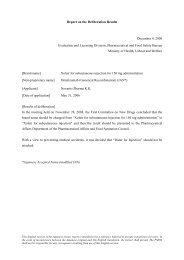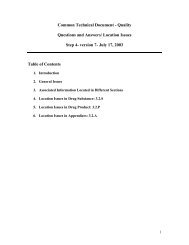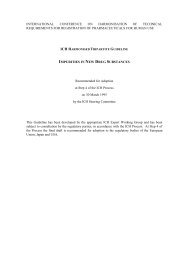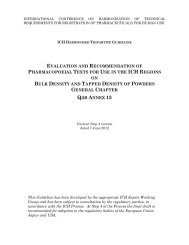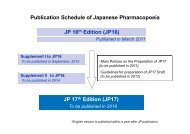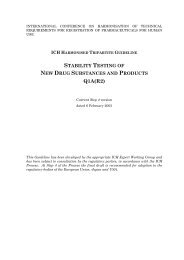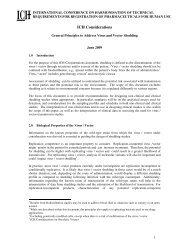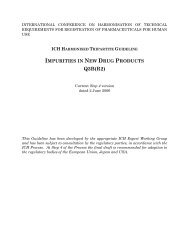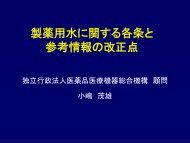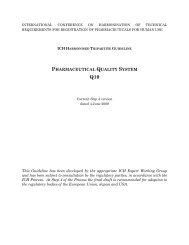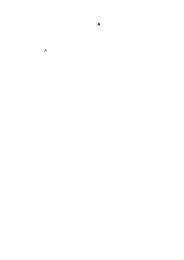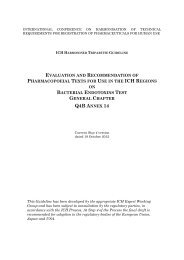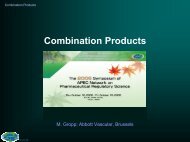4.05 Microbiological Examination of Non-sterile Products
4.05 Microbiological Examination of Non-sterile Products
4.05 Microbiological Examination of Non-sterile Products
- No tags were found...
Create successful ePaper yourself
Turn your PDF publications into a flip-book with our unique Google optimized e-Paper software.
After transferring the contents <strong>of</strong> the container or containers to be tested to the culturemedium add an inoculum <strong>of</strong> a small number <strong>of</strong> viable micro-organisms (not more than100 CFU) to the medium.In both cases use the same micro-organisms as those described above under Growthpromotion test <strong>of</strong> aerobes, anaerobes and fungi. Perform a growth promotion test as a positivecontrol. Incubate all the containers containing medium for not more than 5 days.If clearly visible growth <strong>of</strong> micro-organisms is obtained after the incubation, visuallycomparable to that in the control vessel without product, either the product possesses noantimicrobial activity under the conditions <strong>of</strong> the test or such activity has been satisfactorilyeliminated. The test for sterility may then be carried out without further modification.If clearly visible growth is not obtained in the presence <strong>of</strong> the product to be tested, visuallycomparable to that in the control vessels without product, the product possesses antimicrobialactivity that has not been satisfactorily eliminated under the conditions <strong>of</strong> the test. Modify theconditions in order to eliminate the antimicrobial activity and repeat the method suitabilitytest.This method suitability is performed:a) when the test for sterility has to be carried out on a new product;b) whenever there is a change in the experimental conditions <strong>of</strong> the test.The method suitability may be performed simultaneously with the Test for sterility <strong>of</strong> theproduct to be examined.5. Test for sterility <strong>of</strong> the product to be examined5.1. IntroductionThe test may be carried out using the technique <strong>of</strong> membrane filtration or by directinoculation <strong>of</strong> the culture media with the product to be examined. Appropriate negativecontrols are included. The technique <strong>of</strong> membrane filtration is used whenever the nature <strong>of</strong>the product permits, that is, for filterable aqueous preparations, for alcoholic or oilypreparations and for preparations miscible with or soluble in aqueous or oily solvents providedthese solvents do not have an antimicrobial effect in the conditions <strong>of</strong> the test.5. 2. Membrane filtrationUse membrane filters having a nominal pore size not greater than 0.45 µm whoseeffectiveness to retain micro-organisms has been established. Cellulose nitrate filters, forexample, are used for aqueous, oily and weakly alcoholic solutions and cellulose acetate filters,for example, for strongly alcoholic solutions. Specially adapted filters may be needed forcertain products, e.g. for antibiotics.The technique described below assumes that membranes about 50 mm in diameter will beused. If filters <strong>of</strong> a different diameter are used the volumes <strong>of</strong> the dilutions and the washingsshould be adjusted accordingly. The filtration apparatus and membrane are sterilized byappropriate means. The apparatus is designed so that the solution to be examined can beintroduced and filtered under aseptic conditions; it permits the aseptic removal <strong>of</strong> themembrane for transfer to the medium or it is suitable for carrying out the incubation afteradding the medium to the apparatus itself.Aqueous solutions22/29



